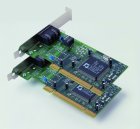ActionTec ActionLink Home Networking Kit
by Mike Andrawes on June 8, 1999 11:54 PM EST- Posted in
- Networking
Hardware
 The
ActionLink package includes two HomePNA NIC's, internet sharing software, a
detailed manual, a driver CD, and a CD filled with games and game demos. All
this comes in at under $100, and additional NIC's for adding more computers
are under $50.
The
ActionLink package includes two HomePNA NIC's, internet sharing software, a
detailed manual, a driver CD, and a CD filled with games and game demos. All
this comes in at under $100, and additional NIC's for adding more computers
are under $50.
The NIC's are based on AMD's PCnet-Home chip, a chip that is based on one of AMD's fast ethernet chips and features 32-bit PCI bus mastering support. The PCnet-Home version supports both regular 10Base-T or HomePNA networks. The ActionLink cards, however, are designed with only HomePNA in mind, and do not feature a 10Base-T port.
The HomePNA standard currently provides for 1Mbps transfer rates, although they are working on a backwards compatible specification with a target bandwidth of 10 Mbps. Unfortunately, 1 Mbps is just 10% the bandwidth of a standard 10Base-T network, and 1% of a 100Base-T network. While that may seem incredibly slow, it is sufficient for sharing most basic applications. If you have xDSL or a cable modem capable of over 1Mbps transfers, all machines besides the one physically connected to the xDSL/cable modem will feel the performance hit during heavy traffic.
The PCnet-Home is also ACPI compliant for enhanced plug-n-play and power management support under an ACPI compliant OS such as Windows 98 or 2000. A wake on LAN header is not included on the card.
There are two phone jacks on the card, one for connecting to pre existing phone wiring, and the other that acts as a pass through for a phone or modem. It also would have been nice to have some status lights on the back of the cards. These are included on most ethernet NIC's and can come in quite handy when trying to diagnose a network problem.
Installation
The hardware portion of the installation is extremely easy - just open your case, locate a free PCI slot and plug it in. Then, run a standard phone cable from the card to a phone jack, and plug your phone or modem into the pass through jack on the card. Repeat for the other systems in the network and your done with the hardware installation. It doesn't get any simpler than this!
As a PCI card, plug-n-play will most likely configure the card correctly in most situations. Just like any standard NIC, the ActionLink cards require a single IRQ. Windows 9x detected the card and asked for drivers. Simply pointing to the CD for drivers kick starts the rest of the software installation. After Windows finishes its job with the drivers, the ActionLink installation program pops up to configure the network. It walks you through assigning network names and then allows you to select drives and printers for sharing.
The internet sharing software, DynaNAT, must be installed separately. It's a simple matter of clicking on the install file. The install program guides you through step by step and keeps it simple by asking for only one or two pieces of information at a time. The software only functions with an ActionTec card installed and selected as the network adapter for sharing.
The extremely detailed manual actually recommends that no other network cards be present in the system with the ActionLink. While this does simplify things somewhat, it is not absolutely necessary. The manual does an excellent job of guiding the user through every step involved in the hardware and software installations. Screenshots of just about everything you will see under Windows 9x or NT 4.0 are given along with the step by step instructions. A troubleshooting guide takes you through potential solutions for some of the most common problems users will encounter.










0 Comments
View All Comments